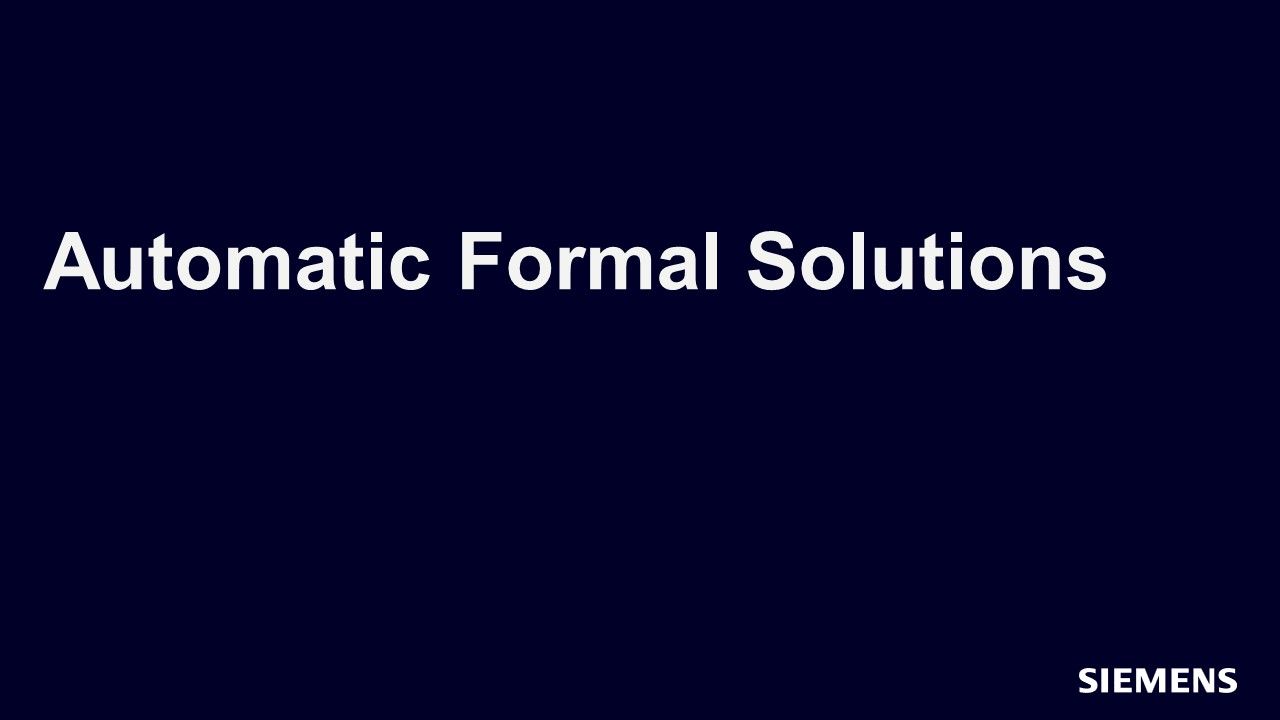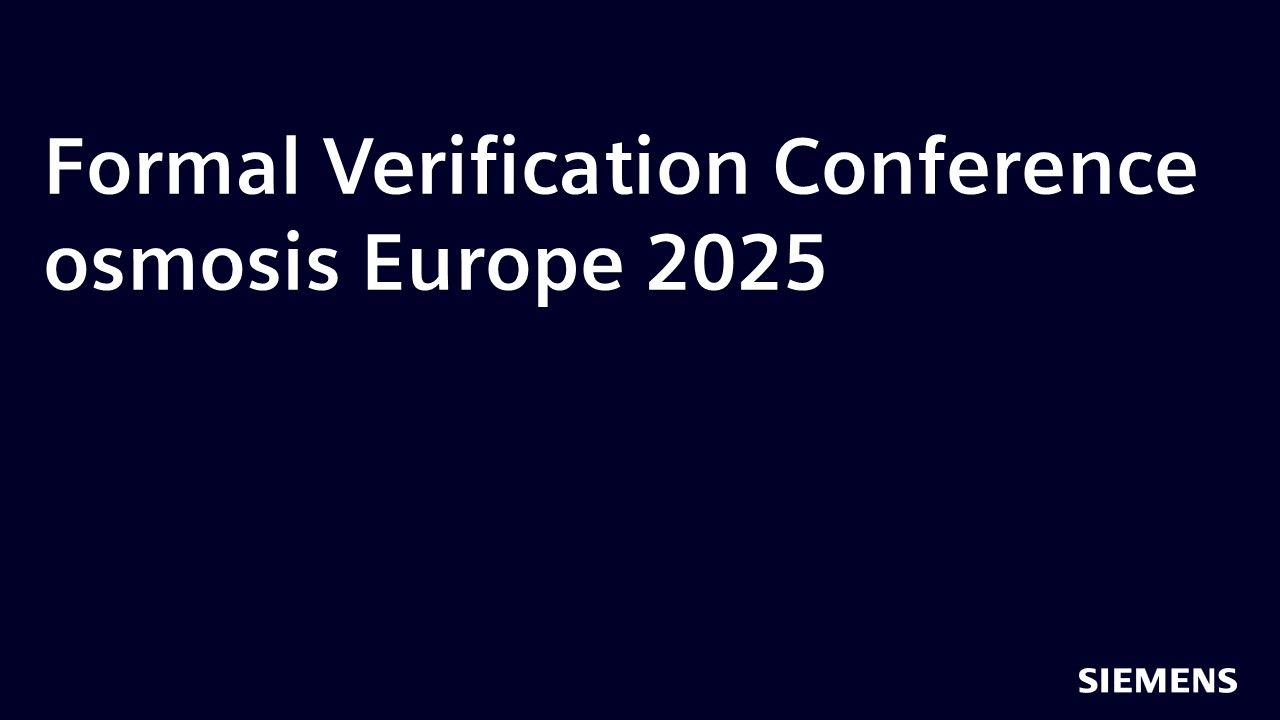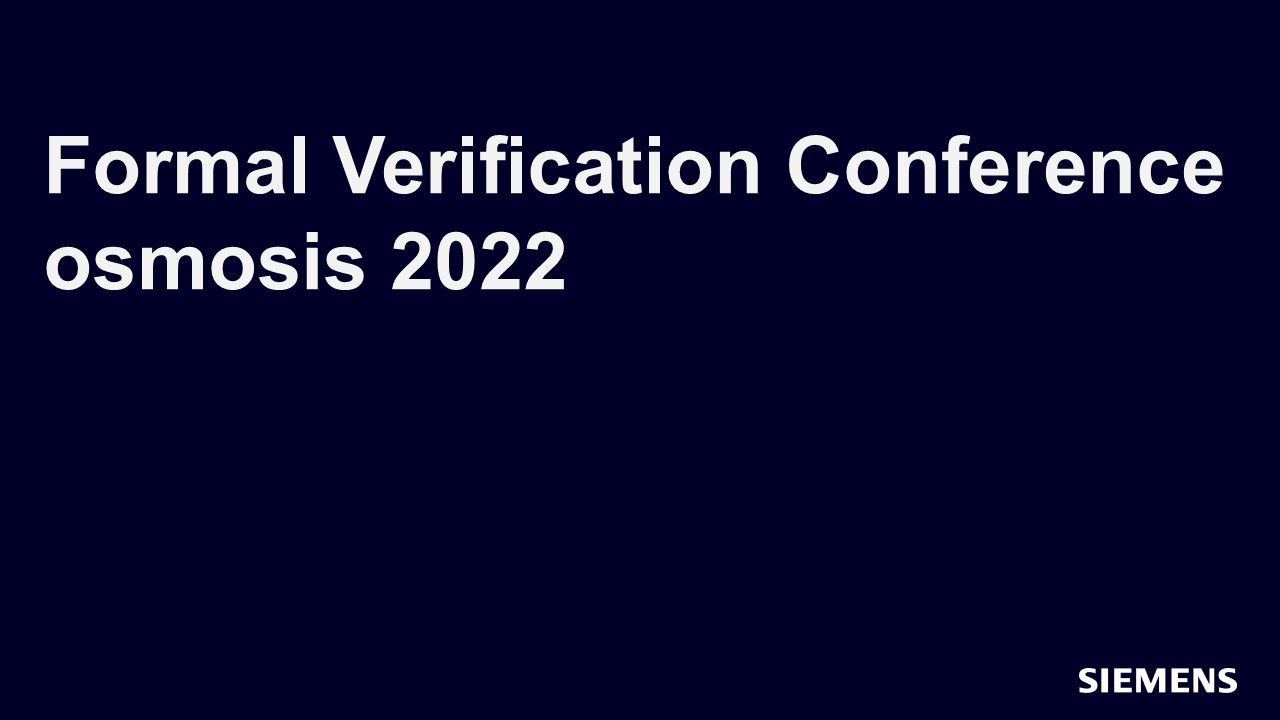Formal Verification
Formal verification is a topic area that encompasses a wide array of formal-based technologies and methodologies, including formal property checking, automatic formal apps, and sequential and logic equivalence verification. By employing mathematical models and logical reasoning, formal solutions scrutinize and validate complex systems, such as hardware circuits with the goal of enhancing reliability and eliminating design flaws.
-

On-Demand
HLV: Formal Verification of Synthesizable C++/SystemC Designs
Siemens HLV tool offerings offer early bug detection immediately after the HLS code is written, including exhaustive formal analysis, comprehensive simulation-based coverage metrics, allowing faster runtime and iteration loops. These are: Formal autochecks for fully pushbutton formula analysis of the HLS design, a variety of formal-based apps, SVA assertion-based formal verification support, comprehensive simulation coverage metrics, and HLS code to RTL equivalence checking.
-

On-Demand
Explore How to Protect Against Data Corruption with Formal Security Verification
This webinar will provide detailed explanations and runtime insights, highlighting the approach effectiveness in enhancing security verification. Learn how to tackle these challenges, improving the robustness of hardware security verification.
-

On-Demand
Streamlining FPU Verification with an Alternative to C-reference Model Approaches
This webinar will introduce you to the Questa FPU application, explaining how it can quickly detect design inconsistencies and reduce verification time from months to days (based on an easy setup process).
-
Formal Verification Tracks
-

Formal 101: Learn Formal the Easy Way
Everyone wants exhaustive verification, and thus people want to learn more about formal property checking flows and tools. But they either don’t where to start, or they are afraid that the learning curve will be protracted and confusing. -

Sequential Logic Equivalence Checking
In this track, you will be introduced to the concept of sequential logic equivalence checking and its common applications. You will also learn how to start with Questa® SLEC to verify design optimization, bug fix/ECOs, low power clock gating logic, and safety mechanisms. -

Formal Property Checking
Questa Property Checking (PropCheck) supports general assertion-based formal verification to ensure that the design meets its specific functional requirements. -

Handling Inconclusive Assertions in Formal Verification
In this track, you will be introduced to techniques to help formal tools solve inconclusive assertions. You will also learn tool options to help convergence, introduce techniques for reducing assertion and design complexity. -

Formal Coverage
Formal coverage is a hot topic these days. Simulation has a number of metrics for helping determine when verification is done. These include code coverage, assertions coverage, transaction coverage, and functional coverage to name a few. -

Formal-Based Technology
This track introduces basic concepts and terminology that should be useful by any engineer wishing to mature their formal-based technology skills. -

Formal Assertion-Based Verification
In this track, you will learn how to get started with direct property checking including: test planning for formal, SVA coding tricks that get the most out of the formal analysis engines. -

Automatic Formal Solutions
After a brief introductory session outlining the general architecture of formal apps, in each subsequent session of this track will deep dive on a specific verification challenge and the corresponding formal application.
-
-
Formal Verification Conferences
-

osmosis Europe 2025
The osmosis Europe event is a dynamic platform for exchanging successes achieved through applying formal techniques to overcome verification challenges. It offers a unique opportunity to connect and engage with our accomplished research and development (R&D) experts and participants.The conversations that follow may help you and others improve formal-based verification solutions. -

osmosis 2025
The annual osmosis event is a dynamic platform for exchanging successes achieved through applying formal techniques to overcome verification challenges. It offers a unique opportunity to connect and engage with our accomplished research and development (R&D) experts and participants.The conversations that follow may help you and others improve formal-based verification solutions. -

osmosis 2024
The annual osmosis event is a dynamic platform for exchanging successes achieved through applying formal techniques to overcome verification challenges. It offers a unique opportunity to connect and engage with our accomplished research and development (R&D) experts and participants.The conversations that follow may help you and others improve formal-based verification solutions. -

osmosis 2023
osmosis is about sharing success in using formal techniques to solve verification challenges, and networking with our R&D experts and other attendees. -

osmosis 2022
osmosis is about sharing success in using formal techniques to solve verification challenges, and networking with our R&D experts and other attendees.
-
-
Formal Verification Forum
-
Issue with Defining a 2D Non-Deterministic Array in Formal Verification Property
May 21, 2025 SystemVerilog -
Query regarding witness for vacuosly passing assertions in Formal Verification
May 16, 2025 SystemVerilog
-
Container - Overview
-
Formal Verification Overview
In the intricate world of semiconductor design and integrated circuit (IC) development, ensuring the correctness and reliability of digital designs is of paramount importance. Integrated circuits are at the heart of modern electronics, powering everything from smartphones and computers to medical devices and automotive systems. The complexity of these designs is continually growing, making traditional verification methods increasingly challenging and error-prone. In this context, formal verification emerges as a powerful and indispensable tool. This comprehensive overview delves into what formal verification of integrated circuits entails and highlights the immense value it brings to the design and verification process.
What is Formal Verification of Integrated Circuits?
Formal verification is a rigorous, mathematical approach to verifying the correctness of digital designs, including integrated circuits. It operates by exhaustively exploring all possible input scenarios to ensure that the design adheres to its specifications. Unlike simulation-based verification, which tests a limited number of scenarios, formal verification aims to provide mathematical proof that the design behaves as intended for all possible input combinations.
Formal verification encompasses several techniques and methodologies, with three primary approaches: model checking, theorem proving, and sequential/logical equivalence checking.
Model Checking (a.k.a. Property Checking):
Model checking involves constructing a finite-state model of the design and then using automated tools to verify that the model satisfies a set of properties. These properties may include functional requirements, safety constraints, and protocol compliance. Model checking systematically explores the state space of the model to identify any violations of the specified properties. If no violations are found, it provides evidence that the design adheres to its requirements.
Theorem Proving:
Theorem proving, on the other hand, relies on mathematical proofs to establish the correctness of a design. Design properties are translated into formal logic, and theorems are then proved using formal logic rules and mathematical reasoning. Theorem proving is often considered a more manual and labor-intensive approach, but it can provide higher assurance and is particularly useful for complex and critical designs.
Sequential/Logical Equivalence Checking:
Sequential and logical equivalence checking of integrated circuits is a vital process in semiconductor design and verification. Sequential equivalence checking assesses whether two sequential circuits, typically the original design and a modified version, are functionally identical. It ensures that the design's behavior remains consistent after modifications or optimizations. Logical equivalence checking, on the other hand, focuses on determining if two circuits are logically equivalent, regardless of their structural differences. It verifies that two representations of a design produce the same output for identical inputs. Both techniques are essential for validating design changes, optimizing performance, and ensuring the reliability of integrated circuits.
Why Adopt Formal Verification?
The value of adopting formal solutions for the verification of integrated circuits is multi-faceted and substantial. Below are key aspects that highlight the advantages of incorporating formal verification into the design process.
-
-
Container - Bullets
-
Column A
- Exhaustive Analysis: One of the foremost advantages of formal verification is its ability to perform exhaustive analysis. It checks all possible input scenarios, leaving no room for undetected design errors. This level of thoroughness is nearly impossible to achieve through simulation alone, which often relies on sampling and may miss rare or corner-case scenarios.
- Mathematical Rigor: Formal verification is founded on mathematical principles and formal logic. This rigor means that when a design passes formal verification, it is supported by a strong mathematical proof of correctness. This level of assurance is hard to achieve through traditional verification techniques.
- Error Detection: Formal verification is exceptionally effective in detecting a wide range of errors, including design flaws, functional bugs, timing violations, and corner-case anomalies. These issues can be subtle and challenging to find using other methods, making formal verification a critical tool for uncovering hidden problems in the design.
- Early Error Detection: Formal verification can detect errors at early design stages, reducing the cost and effort required for fixing issues. Finding and resolving problems early in the design process is considerably less expensive and time-consuming than addressing them later in the development cycle.
- Functional Verification: Formal verification complements traditional functional verification methods. It can be used to verify specific functional properties, ensuring that the design meets its intended behavior. This makes it a valuable tool in addition to simulation-based techniques.
-
Column B
- Safety-Critical Systems: In safety-critical applications like automotive, aerospace, and medical devices, formal verification is essential for ensuring the highest levels of safety and reliability. It provides the assurance that a design will behave correctly under all possible conditions, including those that could lead to catastrophic failures.
- Verification of Complex Designs: As integrated circuit designs become increasingly complex, traditional verification methods may become impractical or unreliable. Formal verification scales effectively to handle the complexity, making it well-suited for modern IC designs with millions of transistors.
- Comprehensive Coverage: Formal verification helps achieve comprehensive coverage of the design space. It can verify the absence of certain undesirable conditions or behaviors, which is often challenging to accomplish through simulation-based coverage metrics alone.
- Regression Testing: Formal verification can serve as an essential part of regression testing. Once formal properties are established, they can be used to automatically verify successive design revisions, ensuring that any changes do not introduce new issues.
- Compliance and Regulations: In regulated industries, formal verification can provide the evidence required to demonstrate compliance with safety and quality standards. This is particularly important for obtaining certifications and approvals in fields like healthcare, aviation, and automotive.
- Debugging Assistance: While formal verification does not replace debugging entirely, it can aid in the debugging process by providing counterexamples when property violations are detected. These counterexamples point to the root cause of the problem, helping designers fix issues more efficiently.
-
-
Container - Conclusion
-
Challenges and Considerations
Despite its many advantages, formal verification also comes with some challenges and considerations that designers and organizations must be aware of:
- Complexity: Formal verification can be complex and may require skilled engineers with expertise in mathematical logic and formal methods.
- Computationally Intensive: Formal verification tools can be computationally intensive, and proving theorems for large designs may require significant processing power and memory.
- False Positives and Negatives: Like any verification method, formal verification can produce false positives (indicating problems that do not exist) and false negatives (failing to detect real issues) due to the way properties and constraints are formatted. Careful analysis and refinement of properties are necessary to minimize these occurrences.
- Tool Selection: Choosing the right formal verification tools and methodologies is critical. Different tools may be better suited for specific design types or verification objectives.
Formal Verification Conclusion
Formal verification is a powerful approach to ensure the correctness and reliability of integrated circuits. Its mathematical rigor, exhaustive analysis, early error detection, and suitability for complex designs make it an invaluable tool in the semiconductor industry. By adopting formal solutions, designers and organizations can enhance the quality, safety, and performance of their ICs, reduce development costs, and gain a competitive edge in delivering robust and reliable electronic products to the market. As IC designs continue to evolve and grow in complexity, formal verification is poised to play an increasingly pivotal role in the design and verification process.
-